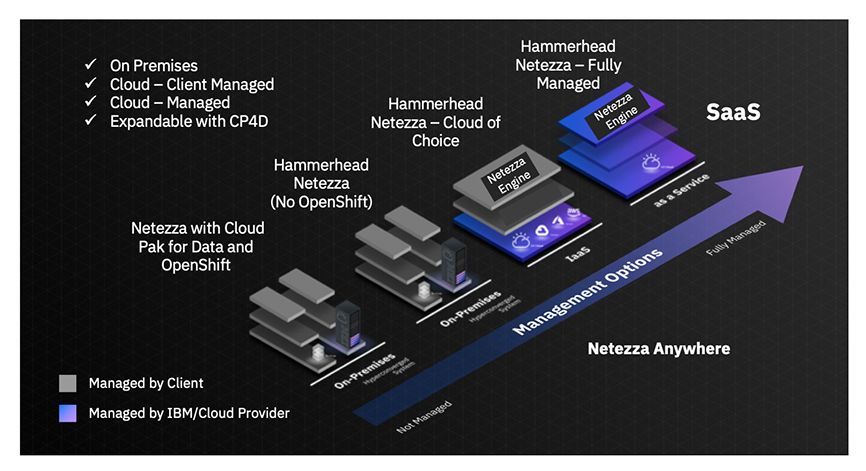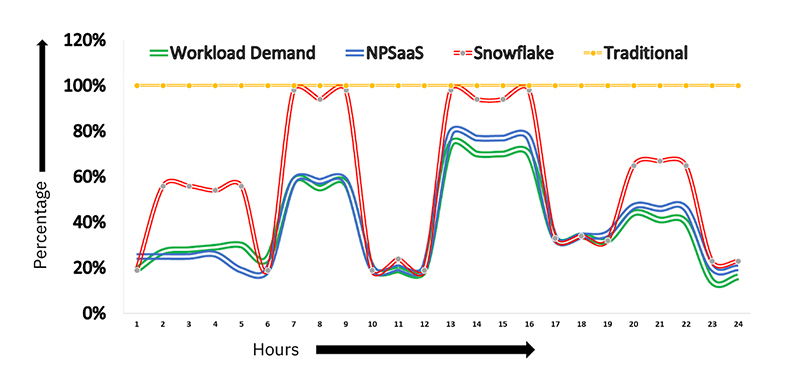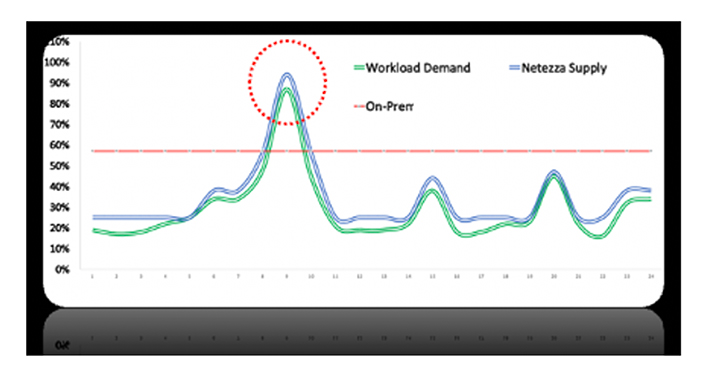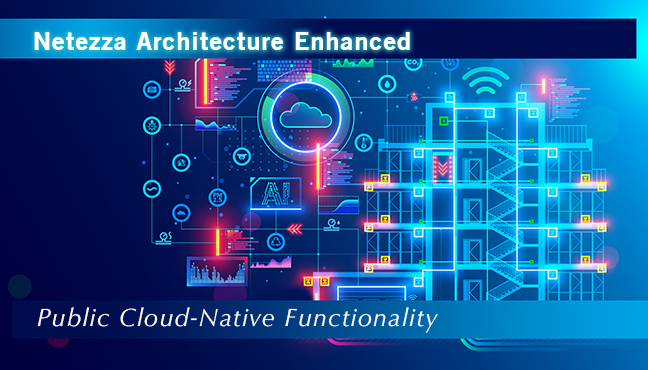Practice Director, Information & Analytics
Have you ever wondered if there will ever be a high-performance data platform that runs the same code base whether it is on-prem or in the cloud? It would also have to be flexible enough to leverage cloud-native storage but maintain the extreme performance and simplicity that is expected in any solution today. Maybe it could also have a unified and extensible architecture by which it could be coupled, creating a much broader end-to-end information ecosystem.
I know many believe that this day would never come, but it is now a reality with the IBM Netezza platform, Netezza Performance Server (NPS). It native Netezza everywhere, whether the organization’s culture is highly sensitive and wants the solution within its data center or is SaaS first in its direction. IBM and the new Netezza platform (called Hammerhead) bring the ultimate flexibility and agility to the high-performance data platform by leveraging a singular high-performance database engine and then optimizing architectural components to meet your organization wherever you are. It can be run stand-alone as the much-beloved high-performance database platform organizations have trusted for years, but now can also be implemented with the end-to-end capabilities of Cloud Pak for Data (CP4D), bringing the ultimate in comprehensive data ecosystem solutions to an organization.

Catch the Wave on the New Hammerhead Netezza
Netezza used to name its solutions after surfboards, from Skimmer to Twin Fin, Mako, etc. IBM has continued this nomenclature with the latest release of the Netezza Performance Server (NPS) offering. The latest version is called Hammerhead and brings even further flexibility into the architecture.
The on-premises version of Hammerhead leverages a component-based system similar to the appliance of the past, but with full flexibility to expand. For ultimate performance, it leverages Field Programmable Gate Arrays (FPGA) to optimize performance of analytic workloads. This on-premises solution gives the ultimate performance per processor.
IBM also brings complete flexibility with the solution as well, which is done through virtualizing the FPGAs in the PaaS and SaaS offerings. The SaaS offering (NPSaaS) delivers the ultimate in elasticity and manageability while maintaining the high performance expected with Netezza. With the core architecture becoming agnostic of proprietary infrastructure, IBM has brought all the best attributes of SaaS offerings to the NPS on public cloud infrastructure. Many cloud database vendors claim elasticity, but as you dig into the details, the granularity of this elasticity is not granular at all. IBM does not believe doubling your environment constitutes granular scaling, as is the only option with one of trendy competitors in the cloud marketplace. Many of the SaaS competitors also have no answer to organizations where a hybrid option is necessary, or they will recommend an architecture in which technology looks unified, only to find out that the solution is only unified in marketing collateral. The NPS is the real deal, with the capability to run the exact same code across all distributions.
The following visual depicts the difference between the competition with coarse grain elasticity and the IBM fine grain elasticity brought to the user’s base with the NPSaaS offering. The graph shows compute on the Y axis and a 24-hour timeframe on the X axis. The Green line shows the actual processing necessary for the workload. The Blue line shows the fine grain ability of the NPSaaS offering to scale to meet the usage needs but doing so without oversizing. The Red line is what we see in the competition (Snowflake), where they claim that coarse grain elasticity is optimal, but as you can see with the sample workload, the environment is completely over provisioned most of the time. The result of over provisioning is a combination of wasted / additional cost from the vendor as well as from the cloud provider.

For those organizations who are running previous Netezza appliances and wanting to stay on-prem, there is honing of the architecture as well. Performance has received a boost through the replacement of legacy spinning disk with Solid State Drives (SSD). SSD also mitigates disk failure rates, a common pain point on the Striper & Twin Fin models. The Hammerhead has all the strengths of the legacy Netezza solutions (Twin Fin, Striper and Mako) but has removed many of the weaknesses — largest of which was the lack of expandability without purchasing an additional appliance. Hammerhead and the NPS have the ability to separate compute and storage, mitigating the largest complaint of Netezza appliance users. At the same time, Netezza has kept all of the sophistication organizations rely on for data science and analytic processing. Whether in the cloud or on-prem, time, ingress and egress cost and duplication of data are all factors that can be mitigated by leveraging the INZA capabilities and bringing the data science heavy lifting into the Netezza instead of pulling the data out and processing it somewhere else. Netezza can process Python, R and Java internally and thus expand the value proposition as well as performance of outcomes.
The NPS is Netezza at its core and has all the functionality to which customers are accustomed, including INZA functions and the core Netezza Platform Software / engine. Thus, migration is a snap. Mainline customers have migrated to the NPS system in hours leveraging common tools such as nz_migrate.
The Netezza host has evolved and now has the option of being containerized, allowing the NPS to plug directly into the IBM Cloud Pak for Data (CP4D) architecture, with expanded breadth of functionality for certain broader use cases. On the other hand, the Hammerhead version of NPS brings the added flexibility of running the NPS without Red Hat OpenShift (OCP), allowing organizations who want the ultimate performance and simplicity that option as well.
Expanded Value with Netezza Performance Server (NPS) & Cloud Pak for Data (CP4D)
The Netezza Performance Server (NPS) can be purchased as a bundled architecture of software including the NPS core software and adaptable appliance (what IBM calls a hyperconverged system). This offering can also be extended with a broad analytics and data processing and data management capabilities called IBM Cloud Pak for Data (CP4D). The CP4D solution includes data collection, virtualization, refinement, governance, and advanced data analytics platform. The CP4D System is designed so that CP4D workloads do not affect the NPS processing or performance and vice versa. The CP4D is a containerized, hybrid cloud architecture where expanded processing needs can be met within the hyperconverged system, on another set of on-premises infrastructure, or on the cloud. All CP4D components, are containerized, running on RedHat Linux (RHEL) and OpenShift (OCP). The bundling of the CP4D software and NPS achieves an end to end data ecosystem. No other company or platform brings the breadth of functionality to one converged solution. With embedded microservices for analytics, reporting, data governance, data fabric, data quality, integration, machine learning and much more, IBM has brought a holistic solution to market.
Business Success Stories
As with any newer solution in the IT market, organizations want to know if all the marketing is reality. “Does this really work?” Mainline has been working with numerous organizations across industry segments such as retail, banking, manufacturing, financial services, healthcare, research, and higher education. One customer has found that their workloads were highly volatile and the legacy on-prem data warehouse architectures of old just did not fit their need any longer. Mainline was able to propose a solution with the new NPS SaaS Solution on Azure Cloud that not only gave the customer the performance and features only found in the Netezza architecture but also a solution that is more flexible and less costly than their on-premises solution.
The customer’s data processing needs prior to NPS SaaS on Azure had them locked into a solution that was static and could not flex or adapt to meet the spikes in their business processing need. Their workload resembled the following diagram, where the legacy solution would be overtaxed for portions of the day (circled in red) and left data consumers frustrated with the slow performance. In other periods the workload was not utilizing the compute power of the on-premises solution and resulting in a waste of resources.

Summary
Mainline has a long history of creating innovative and cost-effective solutions for our customers. With the IBM Netezza Performance Server SaaS (NPSaaS) offering on Azure as well as the new Hammerhead and Cloud Pak for Data Netezza offerings, Mainline has a toolbox full of data processing capabilities to meet the ever-changing business and technical needs of our customers. The NPSaaS solution, with cloud-native functionality such as pause and resume, elastic expansion, and contraction of compute and object storage, the Netezza product is stronger than ever. In addition, the hybrid design of the Netezza Performance Server platform gives customers the ultimate solution flexibility whether the data processing needs are on-premises, in the cloud, or a mixture of both. The Mainline Information and Analytics team understands the strengths and weaknesses of on-premises, cloud, and hybrid cloud architectures and data ecosystems and can partner with your organization to create a solution that best suits your specific data strategy and needs.
More Information:
For more information on analytics, data modernization, and automation solutions contact your Mainline Account Executive directly or click here to contact us with any questions. Our experts can assist you with your digital transformation initiatives and help to improve customer experience and business outcomes.
You May Also Be Interested In:
BLOG: Data Management Using IBM Cloud Pak for Data and AI
BLOG: The Data Governance Corporate Marketplace
Webinar Replay: Evolving with Data and AI – Delivering Value and Efficiencies (46:00)

